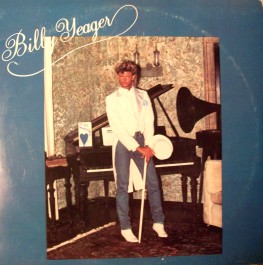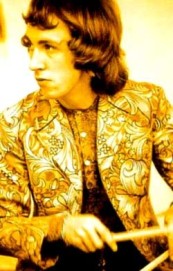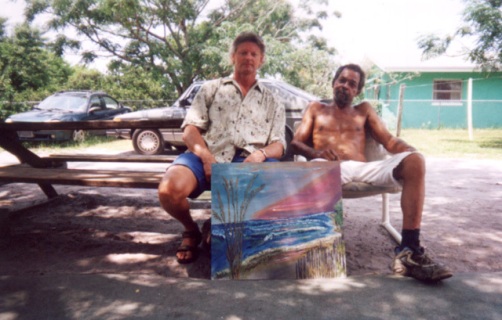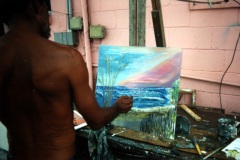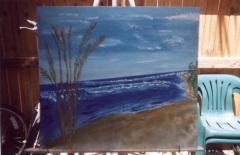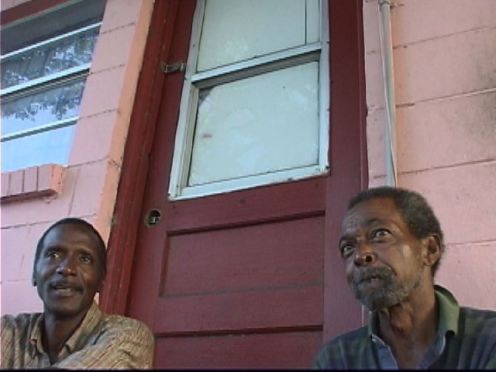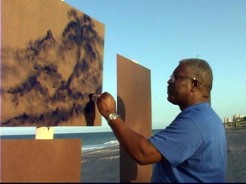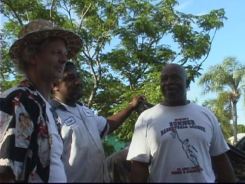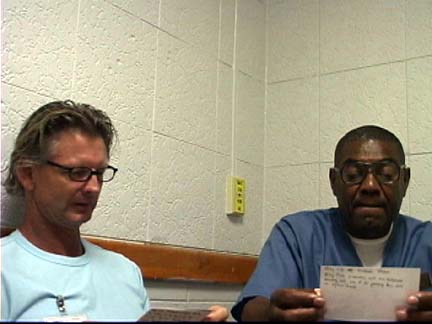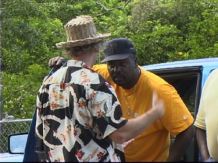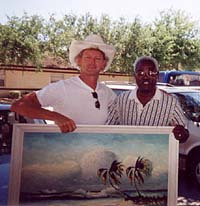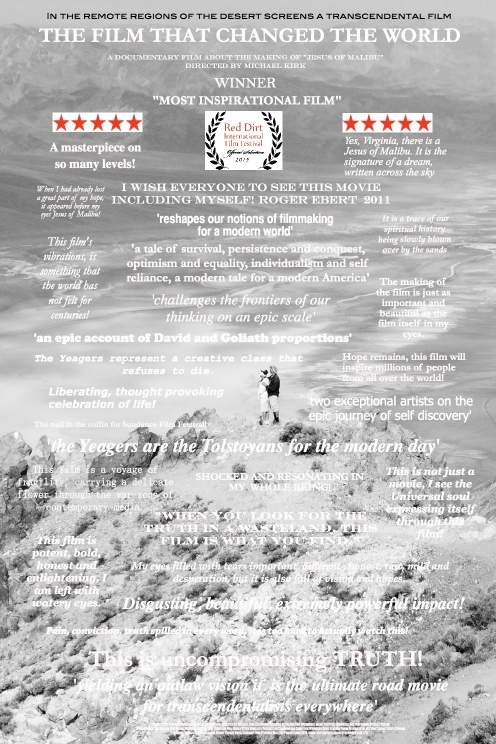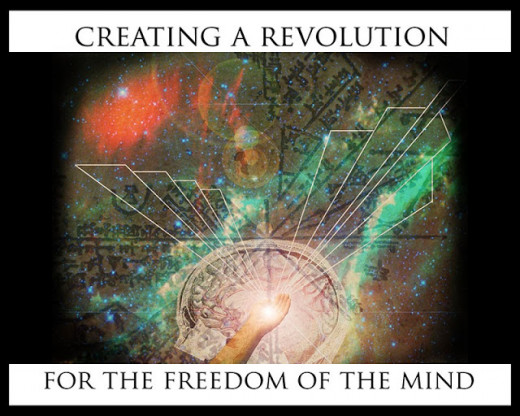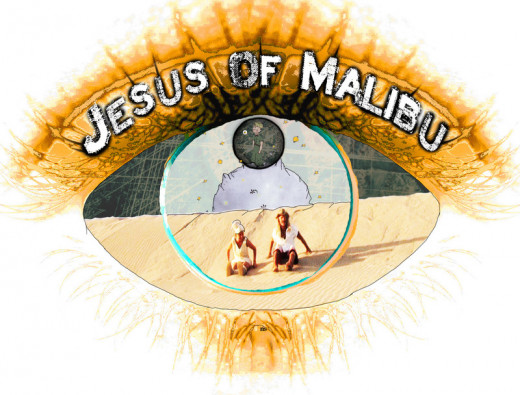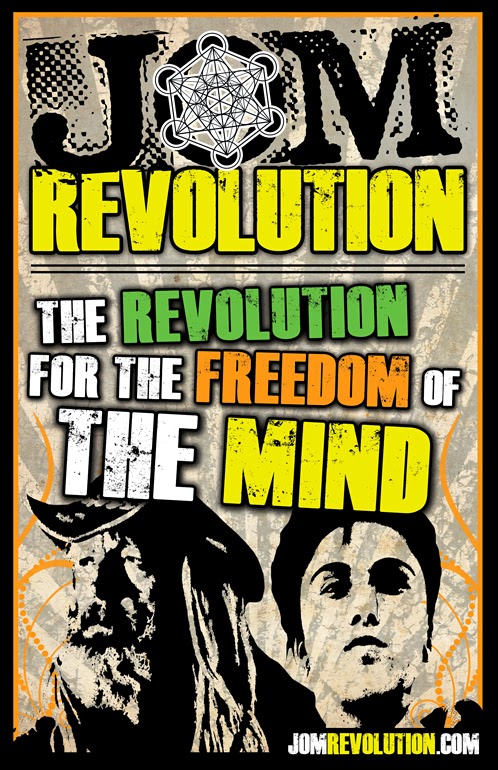www.jesusofmalibu.com
BIO
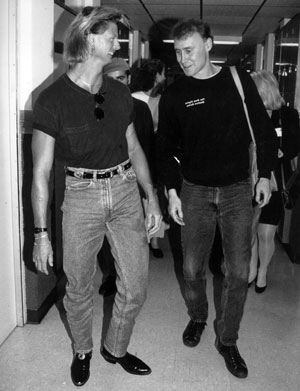




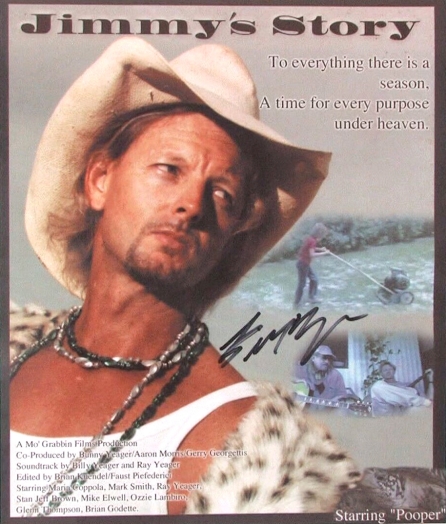
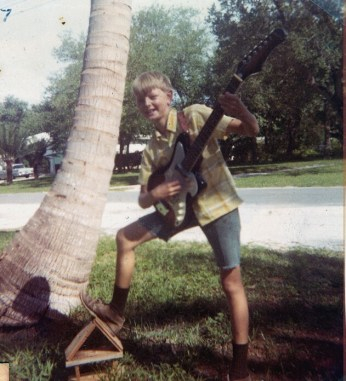
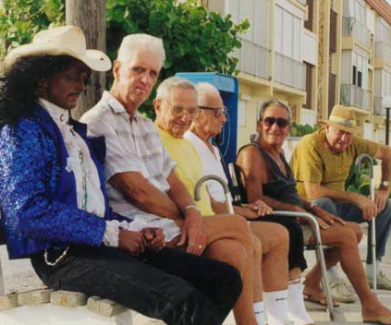
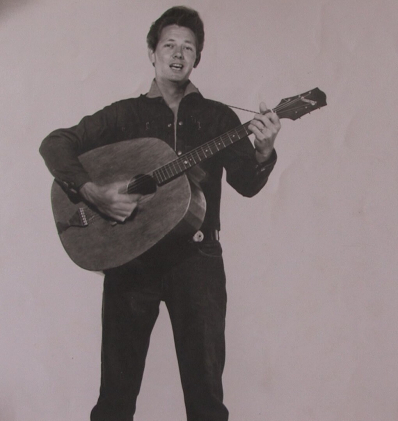
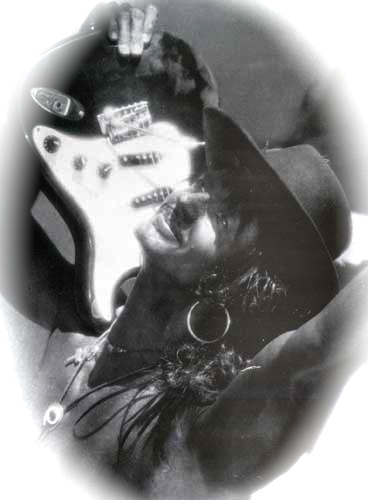
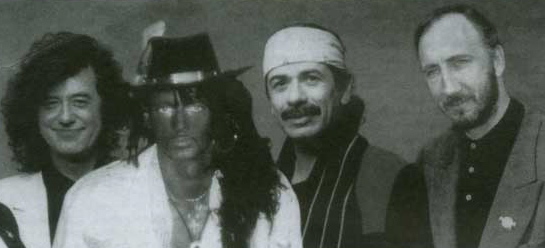
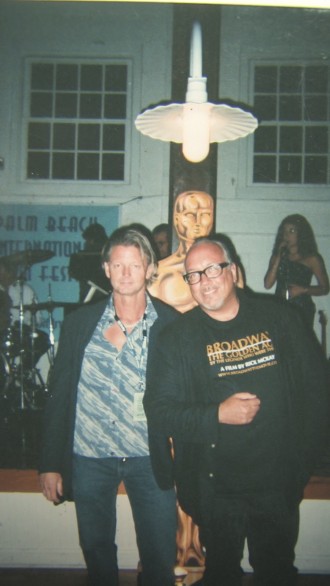 Award winning filmmaker Rick McKay was also attending the Palm Beach International Film Festival with his film Broadway: The Golden Age. Ironically, right after reading a small town newspaper article about Jimmy’s Story, he met Billy walking down the street in Lake Worth, Florida, where he was staying at the Gulf Stream Hotel.
Award winning filmmaker Rick McKay was also attending the Palm Beach International Film Festival with his film Broadway: The Golden Age. Ironically, right after reading a small town newspaper article about Jimmy’s Story, he met Billy walking down the street in Lake Worth, Florida, where he was staying at the Gulf Stream Hotel.
Rick asked Billy for a copy of his film. Unbeknown to Billy, Rick secretly submitted Jimmy’s Story to the Dahlonega International Film Festival, where Rick’s film was going to be screening a week later.
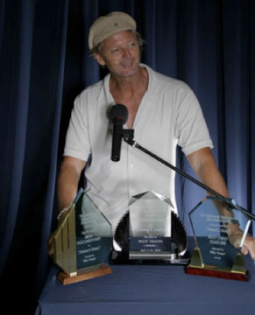


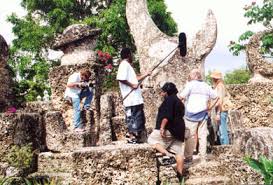



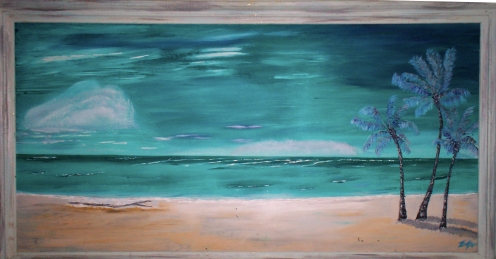
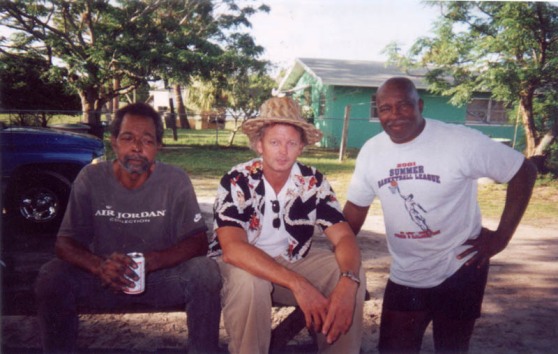
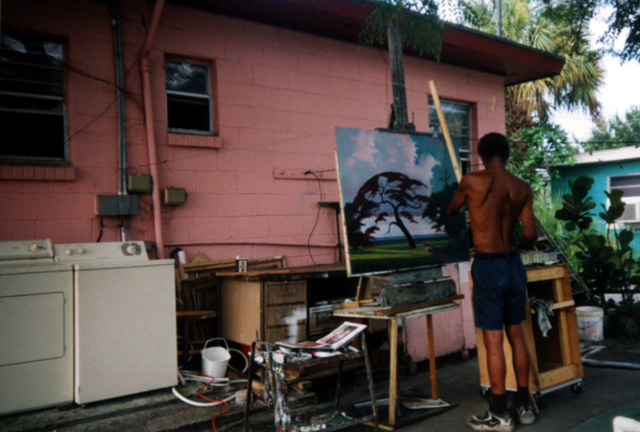
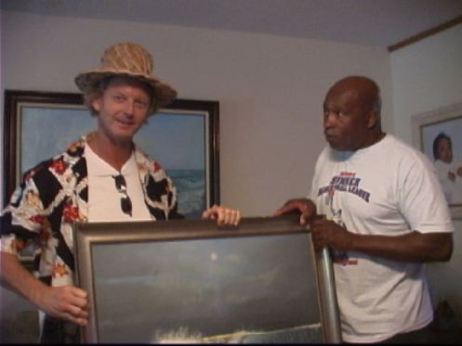
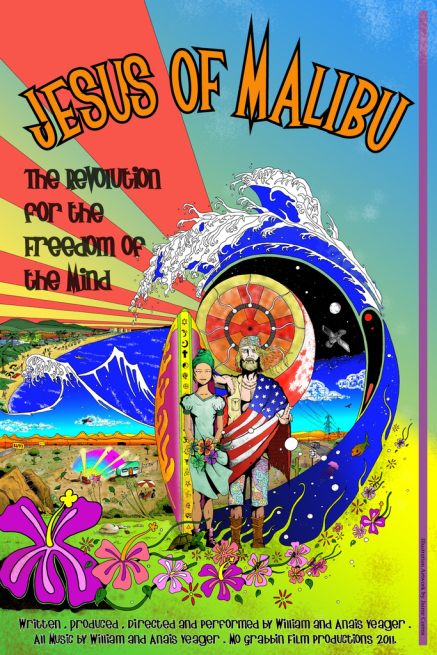


Billy Yeager is a self-taught musician. He has written and recorded over 2600 musical compositions. In his early 20s, he won several National Songwriting contests. He produced his first album, What’s It Gonna Take, in 1983. Over 22 of South Florida’s top musicians, such as Dennis Noday, Rex White, Jay Drake, Alan Layton and Diane Sherrow, recorded on the album.
On his second album, Be My Valentine, produced in 1985, Billy played every instrument. The album was recorded at Circle Sound Studios, which is the private recording studio of the Inner Circle Reggae Band. Yeager was the guitar player for the Grammy Award winning band from 1985 to 1986. Both Bernard “Touter” Harvey and Ian Lewis were involved in the engineering and production of the Be My Valentine album.
Billy has played and performed alongside musicians such as Doug Ingle (Iron Butterfly), Jerry Marotta (Peter Gabriel), Carmine Appice (Vanilla Fudge), Butch Trucks (Allman Brothers), and Pat Travers.
In 1987, Yeager recorded with Ira Sullivan, Eddie Higgins, and Peter “Mars” Cowling on Stan Jeff Brown’s album Transformation Paradox. Yeager also recorded with Jaco Pastorius, who considered Billy one of the greatest guitarists he ever performed with.
In 1983, Yeager recorded a jam session with Jaco and then they went to jam live at the Tipperary Pub in Deerfield Beach, Florida. The performance was filmed on VHS by the bar’s owner and was last seen being auctioned online.
From 1974-1986, Yeager sang and played guitar in many of South Florida’s top bands, working with artists such as Harold Seay and Inner Circle reggae band.
In 1986, Billy quit playing in cover bands and bought his first 4-track recorder (when Billy first began writing and recording his music back in 1978, he had to experiment with small tape decks, recording tracks multiple times, mixing them eventually onto one tape). This was the beginning of Yeager’s songwriting isolation period; for over 6 years, he worked intensively on his own unique style and sound (he even boarded up his windows, so he wouldn’t be aware of the sunlight and time); sometimes a day would turn into night and he would have as many as 3 to 8 written and recorded songs in a 24 hour period. Not a single day would pass where Yeager wouldn’t have recorded at least 3 songs.
During these years Yeager confined himself to a small apartment in Hollywood Beach and took a part time job as a janitor. He would wake up every day at 3 a.m. and returned home at 8:00 a.m. This would allow him to write and record songs during the rest of the day.

In 1991, Yeager gave a copy of his original music to Grammy Award Winner Bruce Hornsby backstage at a concert. Bruce called Billy personally from the road while he was performing with the Grateful Dead; Hornsby was so excited by the demo cassette tape that he personally wanted to help Billy receive a record deal with a major label.
Bruce Hornsby, in an interview with Miami New Times, said (regarding the many demo tapes he received), “The bad news and sad truth is that most of them are really terrible. I’ve been inundated with them for years. Billy’s is really different. It’s possibly the only one I’ve ever heard where I thought, ‘This is something.’ Most of these tapes are so badly done. I mean, why don’t they take more pride in what they are doing? Billy was different. Billy has songs that reach people.”

The demo tape was recorded on a worn out 4-track Fostex recording machine, in Billy’s apartment. Billy played all the instruments; he used not only the common instruments such as drums, bass, guitar and keyboard, but also a mandolin, glockenspiel, bagpipe and harmonica. He also sang on the tape and did all the background harmonies, which sometimes were as many as 5 and 6 parts. Bruce’s manager, Tim Neece, acquired a development deal with Capitol Records, who advanced Billy money so that he could record his songs in a state-of-the-art professional recording studio.
Billy received a management deal with Larrikin management (Gerry Georgettis, road manager for Pink Floyd, Tool, Cold Chisel, Sponge, Henry Rollins), but Bruce and his management company still continued to submit Billy’s songs to the major record labels from1992-1995.
However, in 1992, the music industry had changed and the record labels were mainly interested in signing rap and grunge music, and Yeager fell between the cracks because he was an adult contemporary artist.

“Despite fans like Hornsby and dozens of encouraging letters from recording industry executives, he was not signed to a major record label. From a dresser drawer he takes out a letter written to him by an industry powerbroker. It is effusive in praising his talent, the quality of his tape, his great potential_and ends by saying there will be no offer forthcoming because there isn’t a hit single in the batch of tunes.” Greg Baker

“His eclectic style made him difficult to categorize: rock and roll mixed with jazz alongside reggae rhythms and African pop influences, brooding ballads and high-energy hooks, a gravel-scratching voice backed by sweet harmonies. Lyrics that spanned the reaches from the romantically sentimental to the belligerently defiant. And that guitar_ one as supple and smooth as Herb Ellis, the next a raging reminder of Jimi Hendrix. And Yeager disliked the idea of being known for his guitar virtuosity alone.” Miami New Times
THE SHIFT TO FILMMAKER – JIMMY’S STORY

“Every musician in America should see this film.” Faust Pierfederici
Jimmy’s Story is a combination of several film genres: documentary film, mockumentary, pseudo-docu, docu-fiction, and cinema verite.
Jimmy Story is the name of a fictional character that Yeager created for his film, in which a musician ponders the meaning of life.

“Billy Yeager’s Jimmy’s Story shows not only the trials and tribulations of the journey of trying to make it into the music industry, but also the triviality of the whole idea of becoming “somebody” special, of being a “star”. The film captures reflections of his childhood and the words of wisdom from his father, Ray Yeager.” Aaron Morris (Miami International Film Festival)

The film was featured on an edition of the Bravo/IFC cable show Split Screenhosted by John Pierson; the segment was filmed, edited and produced by Dan Myrick.
Jimmy’s Story also features many people, close friends and neighbors, such as Billy’s landlord, who developed into one of the most prominent characters in the film.
Some of the most cherished segments in the film are Jimmy Story’s visits with The Old Gang. When Billy returned home from his early morning janitorial job, he would often head out with his cameras to the beach bench located on Jackson St., at Hollywood Beaches Broadwalk, where The Old Gang would hang out every day.

Billy Yeager as Jimmy Story with The Old Gang at Hollywood Beach, Florida.
Billy filmed and recorded conversations with The Old Gang for over 12 years.
In the very beginning, there were 6 members, but as the years went by, they all passed away. Yeager kept recording until the last gang member passed on.
During the filming of Jimmy’s Story, Billy’s landlord also passed away.
Despite his struggle with cancer, Billy’s father, Ray Yeager, wanted to keep performing in the film until the end. Soon after the first screening of Jimmy’s Story, he passed away.

Ray Yeager with his Big Ole Red homemade guitar, in 1965.
Dark hair and 6 feet 7 inches tall, with a homemade guitar made out of a dresser drawer, country singer and songwriter Ray Yeager stepped off the bus in Nashville, Tennessee, in 1965, and 5 minutes later, he was signed to a 5-year recording contract with MGM Records.
Everyone who knew Ray believed he was going to be a big star, but it never happened; Ray simply walked away from it all.
The film is a parable and a riddle. Throughout the film, Ray speaks his own words of wisdom about the small things in life and the meaning of success. In one scene, Ray and his son sit in the cemetery by a tomb reflecting on the meaning of life and death, purpose, and acceptance.
Yeager chose to begin and end Jimmy’s Story with a quote from The Book of Ecclesiastes: “all is vanity and chasing the wind.”
Creating a film with a vision.
Billy began to realize the negative side of the corporate music industry and began to loathe what he had once desired.
Understanding the significance of producing a film and presenting it to the public, and infused with a sense of purpose as an artist, Yeager decided he wanted to challenge the audience’s perception about fame and success, and society’s obsession with celebrities, while also exposing the media and the press that promote sensational news and trivial matters to the public.
In 1995, Billy began to film his “Jimi Hendrix / Jimmy Story performance art and pop culture & media protest.”
Billy, as his character Jimmy Story, painted his skin black and promoted himself as Jimmy Story, the long lost son of Jimi Hendrix.

The Lost Bolero Tapes
Yeager wrote and recorded music which he called “The Bolero Tapes”; these recordings were supposed to be original Jimi Hendrix compositions that were believed to be lost.
Some publications wanted to get an opinion from the experts.
The music was forwarded to those who had closely worked with Jimi Hendrix, such as Buddy Miles and Mitch Mitchell.
Yeager’s songs sounded so much like Hendrix that the experts were convinced.
“Working as close to Jimi as I did, I would have to say, I know the Hendrix sound, if someone were to try to fake his music compositions, I would be the one who would know. This kid, son of his, whoever he is, the song “Devil’s got a Sweater” is definitely a Jimi Hendrix composition. There is no doubt in my mind.” – Buddy Miles
“Working with Jimi, listening to him jam, rehearse, write music, I know if I hear a song that was composed by Hendrix, I can tell instantly, from phrasing, chord structures, movements from bridge to chorus, etc. With regards to Jimmy Story and his mother Sunshine, I do not know about, but I can tell you, these songs cannot be faked. Jimi was working on music before he died called the Bolero Tapes, if this is the music and this is his son, from the musical stand point, there is no question about it, you can fake a guitar, maybe a little of his voice, but lyrics, and melody, it’s not possible, from what I hear this kid is the real deal, and I would love to play with him.” – Mitch Mitchell
Jimmy Story’s performance artwork was a success; Jimmy Story was featured as a “Cover Story” on WSVN (Miami television) and in XS Magazine, Broward’s alternative newspaper. Billy used his “Jimi Hendrix / Jimmy Story performance art and pop culture & media protest,” including the behind-the-scenes footage, towards the end of Jimmy’s Story movie.
“Undoubtedly, Story’s guitar playing is extraordinary. It’s certainly influenced, if not genetically driven, by Hendrix. It’s Story’s voice that is most convincing, a deep, mumbling inflection that will cause most listeners to do a double-take.” Bob Weinberg , XS Magazine

“They are blinded, but not with wine. They are drunk and they stagger, but not with wine. To whom shall I give the message? Whom shall speak the message?” Jimmy Story, XS Magazine
Glenn DeRosa was responsible for much of the filming of Jimmy Story’s performance artwork segments; Billy added Glenn as one of the producers of the film in 1996. Billy’s aunt Bunny Yeager was also an associate producer.
Jimmy’s Story was completed in 1997 and premiered at the Palm Beach International Film Festival in 1998, winning an award for Best Documentary.
“An outstanding film that is a remarkable achievement, I can’t imagine how much work went into this very personal original film.” Heath McKnight (Awards ceremony at The Palm Beach International Film Festival.)
From 1997 to 2003, Yeager edited over 6 different versions of the film.
 Award winning filmmaker Rick McKay was also attending the Palm Beach International Film Festival with his film Broadway: The Golden Age. Ironically, right after reading a small town newspaper article about Jimmy’s Story, he met Billy walking down the street in Lake Worth, Florida, where he was staying at the Gulf Stream Hotel.
Award winning filmmaker Rick McKay was also attending the Palm Beach International Film Festival with his film Broadway: The Golden Age. Ironically, right after reading a small town newspaper article about Jimmy’s Story, he met Billy walking down the street in Lake Worth, Florida, where he was staying at the Gulf Stream Hotel.Rick asked Billy for a copy of his film. Unbeknown to Billy, Rick secretly submitted Jimmy’s Story to the Dahlonega International Film Festival, where Rick’s film was going to be screening a week later.
“Billy was creating reality television way ahead of his time, I loved the film and I suppose you could thank me for being partially responsible for Jimmy’s Story.” – Rick McKay
Heralded as a major achievement, Jimmy’s Story won an unprecedented 4-awards at the DIFF, including Best First Film, Best Documentary, Best Folk Film, and Best First Time Director.
Dean Treadway, the program director at the DIFF Film Festival stated, “This great film, this near masterpiece of amateur filmmaking, a Sundance reject that deserves to tower above most of their eventual winners, is about one man’s perseverance in believing that there is a better future out there, one that has him doing exactly what he feels he’s meant to do. Out of the 700 films submitted Jimmy’s Story is the one that moved me most to tears of joy and frustration.”

The Controversial Performance Artwork.

However, there was a major fallout with some members of the press, who did not embrace the message of Jimmy Story’s performance artwork.
They labeled Yeager’s Jimmy Story performance art simply as a “Hoax.”
Yet, within that same retraction letter from XS Magazine, they also state that Yeager
“was correct” and “proved his point” in that “celebrities are more revered than artists, that being famous doesn’t equate to being talented, that the “lost son” of Jimi Hendrix could get more attention than a local musician.”
Miami New Times writer Greg Baker was also quoted about Jimmy Story’s performance artwork and pop culture & media protest as saying “I think Yeager wanted to use the media to achieve that end, tearing down the corrupt media industrial complex, which is contributing to the downfall of society, I am all for this sort of thing. I don’t think anybody did anything wrong.”
Over 20 years later, the media still tries to marginalize Yeager’s work; of course…, after all, they are “The Media.”
A PERFECT SONG

Yeager’s next feature film was called A Perfect Song, which he wrote, produced, and directed; he also composed and recorded all the music for the film.

The film was made with no money. Yeager shaved his head and gained 35 pounds for the lead role of Lloyd. He also performed the role of Lloyd’s brother, which he filmed before he shaved his head.
Yeager won best actor at the Delray Beach Film Festival in 2004.

Credit: Gary Brice / Billy Yeager as Lloyd underwater
“This film has real charms, what’s great is the sincerity of a creative obsessive character playing a creative obsessive character musing about God and creativity. There are scenes of Lloyd producing ambient music in his gadget studio, plus delightful local color, including Florida fauna and a sympathetic tour of the legendary Coral Castle.”
Delray Beach Film Festival, 2004
Delray Beach Film Festival, 2004
The Highwaymen / The Other Side of the Road
The Highwaymen were mostly self-taught painters who painted on inexpensive Upson board. The name refers to African American artists, mostly from the Fort Pierce area, who painted landscapes and made a living selling them, door to door, to businesses and individuals throughout the state from the mid-1950s through the 1980s. They also were peddled from the trunks of their cars.
In the early 1990s an interest in “outsider art,” or art which is created by artists who are outside mainstream society, developed in the art world and in 1995 an article was written for a journal by Jim Fitch, who coined the group the “Highwaymen” because of their tactics of traveling I-95 and A1A to sell their artwork. Not long after this, the New York Times wrote an article on the Florida Highwaymen and two books on the group were published, causing the value of Florida Highwaymen art to skyrocket.
In 1999, Billy Yeager began to seek out all the existing members of the group, including many that were not mentioned in the books that were published.
In 2000, Yeager produced a film documentary called

Gary Brice was the production coordinator and cameraman. Together, Gary Brice and Billy worked for over 1 year on the film.

Yeager was taught how to paint Florida Landscape paintings on masonite boards by one of the original Florida Highwaymen, Livingston Roberts, also known as “Castro,” who was inducted into the Florida Artists Hall of Fame in 2004.

Blue Daze by Billy Yeager
Billy used his paintings for the covers of some of his handmade CDs.
ON THE DOCUMENTARY THE HIGHWAYMEN THE OTHER SIDE OF THE ROAD,
Yeager discovers where the Highwaymen gather to paint and captures rare moments with artists Charles Walker, Johnny Daniels, Jimmy Stovall, and Livingston Roberts all gathered together talking about the old days, Alfred Hair, Al Black, and the lost Freddie paintings.
Yeager interviews Alfred Hair’s family and others who knew Alfred personally.

Yeager with Charles Walker and Livingston Roberts in Ft. Pierce, FL.
Yeager also finds Jimmy Stovall, who once painted with the 5 original Highwaymen when he was only 16 years old, and stages a reunion with Livingston Roberts in his backyard. (They hadn’t seen each other in 25 years.)

Livingston states on camera, “There’s a real Highwaymen, he was here from the beginning.”

- Jimmy Stovall with Alfred Hair’s very first painting on canvas.
Today their 100,000 plus paintings have gathered significant interest and have become quite collectible. At auctions these particular painters works have been recognized with high prices. In recent years there has been many forged paintings sold on eBay and at many galleries. Because there are over 26 artists and they signed their names scratched with a nail into the paintings that were still wet makes it easy to purchase similar Florida scene paintings and forge the artists names who only knew how to print.

Billy Yeager with Charles Walker
Livingston Roberts showed Yeager not only how to paint but how to recognize authentic Florida Highwaymen Paintings.
In 2002 Yeager was featured on FOX NEWS:
JESUS OF MALIBU

Billy and his wife Anais met in 2005 and spent the next 7 years making their film trilogy Jesus of Malibu.
The film was completed with no financial backing and not even a one person film crew.
Sebastian Beach One Fine Day
After completing Jesus of Malibu, the Yeagers returned back to Florida to produce a documentary surf film resembling the old style surf films from the late 1950s and 1960s.
Drew Kampion, former editor of SURFER, SURFING, and SURFERS PATH magazines stated, “The wonderful thing about this creative product of the combined wills and imaginations of Anais and Billy Yeager is how profoundly it succeeds in quietly crystallizing an alternative reality in the here and now.”

The Film that Changed the World
In 2013, the Yeagers were contacted by Maltese Productions, who offered to produce a film documentary about their story and the making of their film Jesus of Malibu.

Click image below to watch music video created by Nick Duggan and Billy and Anais:
The Yeagers continue to create art, music and films to change the world.
Their mission is to raise consciousness and help those who cannot help themselves.


